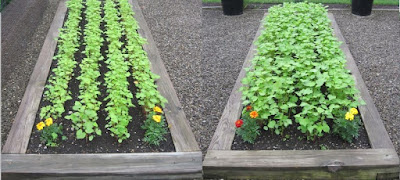I can't believe it's been two weeks since I blogged. I was doing really well all summer. I guess I've been busy with Fall Chores. That's easy to do. Shampooing carpets, washing tractors, putting away equipment, dividing daylilies and hosta, cutting down perennials, digging potatoes, preparing apples, preparing apples, preparing apples. Broken record there. But it's the truth.
When I dug potatoes I found some unwanted, wandering horseradish. More about that later. It is shaping up to be a good year for potatoes. I only had a sparse handful of small, irregular spuds that I tossed. Everything else is large and storable. I still have to dump the bagged potatoes that I consider my main crop. These were the extra that I planted because I didn't know what else to do with them.....
Thanks to our resident Fisher Cat, we are getting low on squirrels. I know those of you with fowl or small livestock will be cringing right now, but we were so over run with squirrels the last few years that I'm totally OK with it.
 |
| Game Cam shot of the Fisher |
And because we are low on squirrels, for the first time since 2018 we have apples in the "orchard trees". The "orchard trees" were in the corner of our lawn leftover from the last residents. They were nearing the end of their life span and we are down to one Macintosh tree. The Yellow Transparent we cut a few years ago because it was a wildlife MAGNET and not in a good way. We rarely got a single apple between the crows and the squirrels and the deer. They are a soft, early apple and we were absolutely over run with critters. So we cut it down.

That left us with a Macintosh and and Empire tree. The Empire tree died this summer. When we finally decided she had "had it" we just pushed her over gently with the tractor and hauled her back to the burn pile. That leaves us with the Mac. We got a nice bushel of apples off of it, but we are going to have to plant a couple more trees because the Mac doesn't look good either and I need a pollinator for the Northern Spy trees by the garden. The Macintosh are very sweet and make lovely applesauce. All of these apples are now sauced and frozen.
I have been dehydrating the Northern Spies as they fall. I think I am on the eighth batch today and I have some of those in the freezer too. I pick half a dozen ripe ones each day and still, whenever I walk by I find this...
I managed to plant some fall color. I replaced the petunias with mums.
Our Fall Ungardening starts by cutting back all of the daylilies. It is actually refreshing to see some bare ground this time of year. It makes it easier to deal with the oak leaves too.
I have been dividing and moving daylilies and hosta around in the front landscape bed. We had to remove a good sized Lilac Tree from here this spring and there is still space to be filled.
The Big Drain also gets cut back hard.
 |
| Its usual look - wild and wooly |
Now it is refreshingly blank. And I can get in there and hoe out some of the Houttuynia cordata roots. Chameleon Plant is attractive and useful and in the right situation is a great ground cover. But that stuff is super invasive and requires some annual maintenance. I really do love how it creeps into the stones and naturalizes, but this time of year it gets a few doses of Spectracide to keep it in check. You can see a little planting area on the left edge below. I dug out all of the daylilies, divided them, purged them of "hootenany root" and replanted. I now have nine gallon pots of daylily that need to find spots. If they survive the winter in pots (they will) I'll re-plant them in the spring.
 |
Dose #1 of Spectracide
Lightly browned but not yet defeated |
Not everything is cut back.
Some things are right in their prime like this Cherry Cola heuchera
And the River Bed is a peaceful, breezy place this time of year.
The Japanese Silver Grass is just now putting out seed heads.




















































